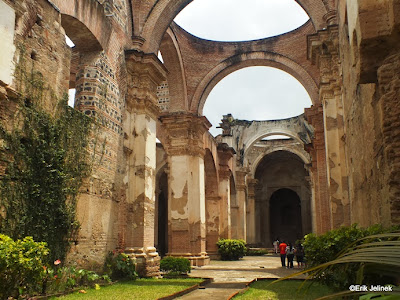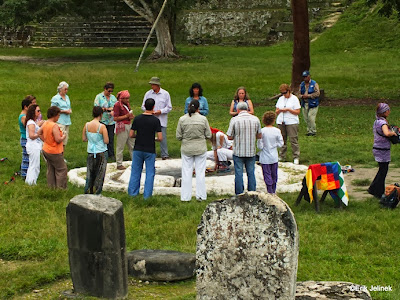Of all the countries of Central America Guatemala is hands down the richest in terms of cultural heritage. Not only was its territory was the cradle of the classic Mayan civilisation but, what is less known, it was also the seat of the Spanish viceroyalty that consisted of the entire region, from southern Mexico all the way to Panama. This is where the rich and powerful of colonial Central America lorded it over their indigenous subjects. Even post-independence Guatemala was the dominant country amongst the small statelets of the region. It wasn't until the inevitable civil war of the second half of the last century that pitted left wing intellectuals, reformists and guerrillas against US-backed right wing genocidal military dictatorships and death squads that the country became a byword for violence, danger and rural misery. Things have quietened down a bit over the past 10 years (a lot less violence but still plenty of rural misery as the right wing military elite are still in power) and the tourists have returned to see what they had been missing out on.
 |
| Quiche Maya lady in traditional costume selling embroidery to tourists. |
Antigua* was the centre of colonial Central America. It rivalled the likes of Bogota and Quito in riches and splendour, right up until 1773 when a powerful earthquake flattened the city. What with the earth moving and the nearby mountains smoking the Spaniards realised that they may not have chosen a judicious location for their capital and decamped 40kmeast to what is now Guatemala City, leaving Antigua in ruins. Some, however, decided to stay in the few decent houses amongst the rubble, thereby preventing the place from falling into complete disrepair. So when rich Guatemalans from the capital "rediscovered" Antigua a century ago with its quaint, original colonial charm. Quickly it became a haven for the moneyed elite and expat Gringos, giving the town a faint theme park feel. Nevertheless there is no denying Antigua is the most gorgeous colonial town in all of Central America. And for me the congregation of churches in various stages of decay and ruin - odd pieces of masonry rubble still lying around, the odd stucco angel still clinging to a niche, and traces of fresco still visible on the walls - just serve to add to its beauty.
 |
| Despite lying in ruins for over two centuries Antigua's cathedral still maintains a grandiose majesty. |
If Antigua is the acme of colonial sights, the highlands to its west and north are equally so in regards to indigenous culture. As I've already mentioned, the classic Mayan civilisation disappeared almost a thousand years ago, but the Mayans as a people carried on regardless. Much of the physical heritage has gone, but the intangible is still strong: the language and calendar are still dominant amongst the indigenous community. And although Christianity is the universal religion, it is just a thin veneer over original pagan beliefs. In many places old shrines are regularly visited and offerings given to the old gods and spirits. Certainly you will hear more Mayan, with its pleasantly "clicky" syllables, spoken than Spanish in this region, and colourful traditional clothes are readily seen (at least on women).
The indigenous and the colonial are nice enough but they're a distant second when it comes to what really draws the tourists to Guatemala. Ancient Mayan pyramids soaring above the canopy of a sea of trees in the middle of the jungle, where you can see eye to eye with swinging monkeys and nesting toucans, is the image that is indelibly linked to Guatemala. The star of the show is undoubtedly Tikal, deep in the lowland forests of Peten. In the 5th-9th centuries AD it was the predominant Mayan city, its rulers subjugating much of the Mayan realm until it too faded into obscurity during the Mayan collapse. During the height of Tikal's power many towering pyramids were built, with Temple IV (archaeologists are not always the most imaginative of people) topping out at a whopping 70m. Unfortunately due to the wet weather that makes Tikal's polished, mossy, limestone structures treacherously slippery all the tall pyramids were closed off to prevent stupid tourists from falling off and dying. Despite my slight disappointment it is still one of the great ancient ruins of the world, due in part to its jungle setting that affords you the chance to see spider monkeys swinging from the vines overhead, tropical birds flitting from tree to tree, and howler monkeys grunting in the distance. Of course it also means heat, humidity and your own personal cloud of mosquitoes to follow you around, but still magical. I'm only sad I didn't have more time to spend there, because even further into the jungle, near the Mexican border, far from any road that requiring two days of hiking just to get there, lies El Mirador, a ruined city that is almost certainly larger, and significantly older, than Tikal. Excavations are still very much ongoing and every year new structures are brought to light from beneath the enveloping jungle. This is truly the daddy of of all Mayan sites, but one that will have to wait for some other time.
*The name Antigua means ancient, referring to the fact that it was the capital before Guatemala City. However it was neither the first nor the second capital, and was in fact the third incarnation of Santiago de los Caballeros de Goathemalan (naturally it wasn't called Antigua when it was founded). The first Santiago had to be abandoned due to local indigenous uprisings, the second† due to a volcanic eruption and the third to an earthquake. The Spanish probably thought the name Santiago was not so lucky, or their patron saint really couldn't care loss, so called their fourth and final capital simply Guatemala City.
†Confusingly the second incarnation of Santiago is now called Ciudad Vieja, meaning Old Town, which I find highly confusing as, although it sounds old, doesn't sound quite as old as Antigua, despite predating it. Names are indeed complicated things.


1 comment:
I'd never heard of El Mirador before, but just ran a Google Image search and it looks brilliant. To be honest South and Central America aren't at the top of my priority list, but the more I read along with you the more I consider whether it should be higher. Looking forward to the rest!
Post a Comment